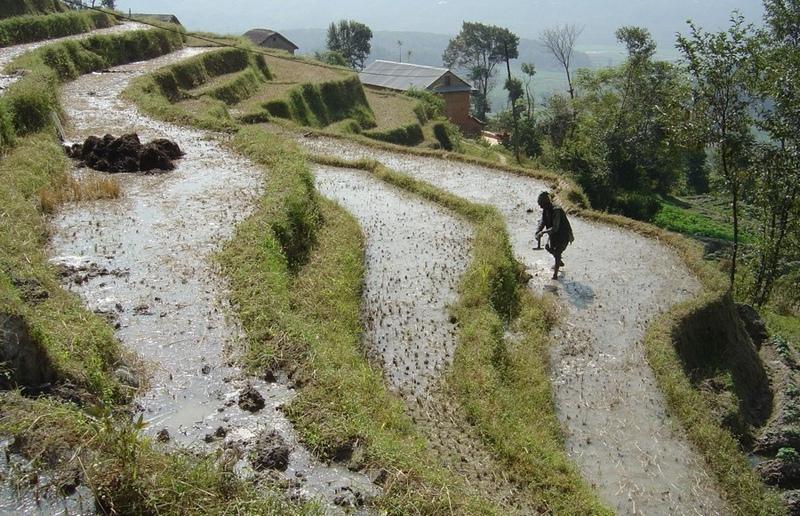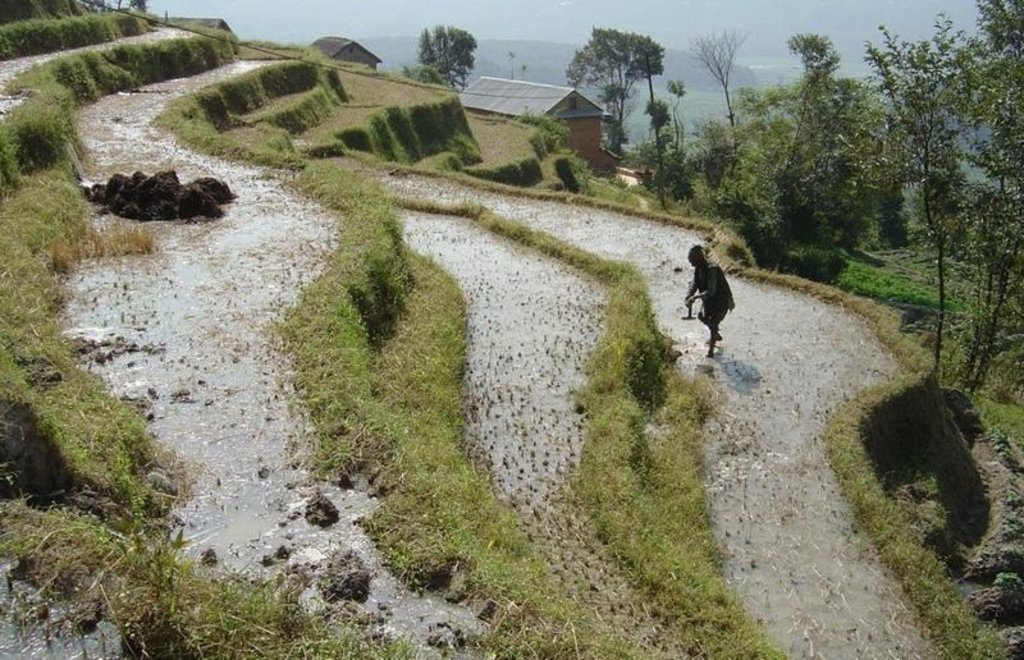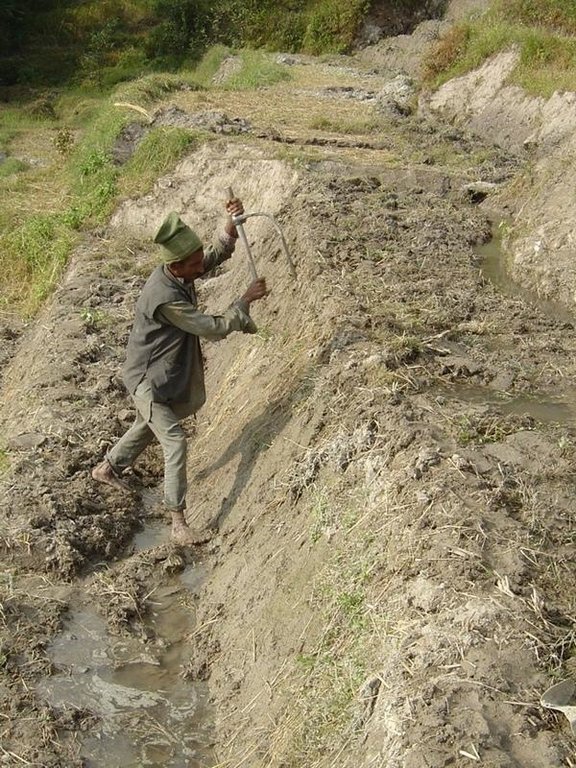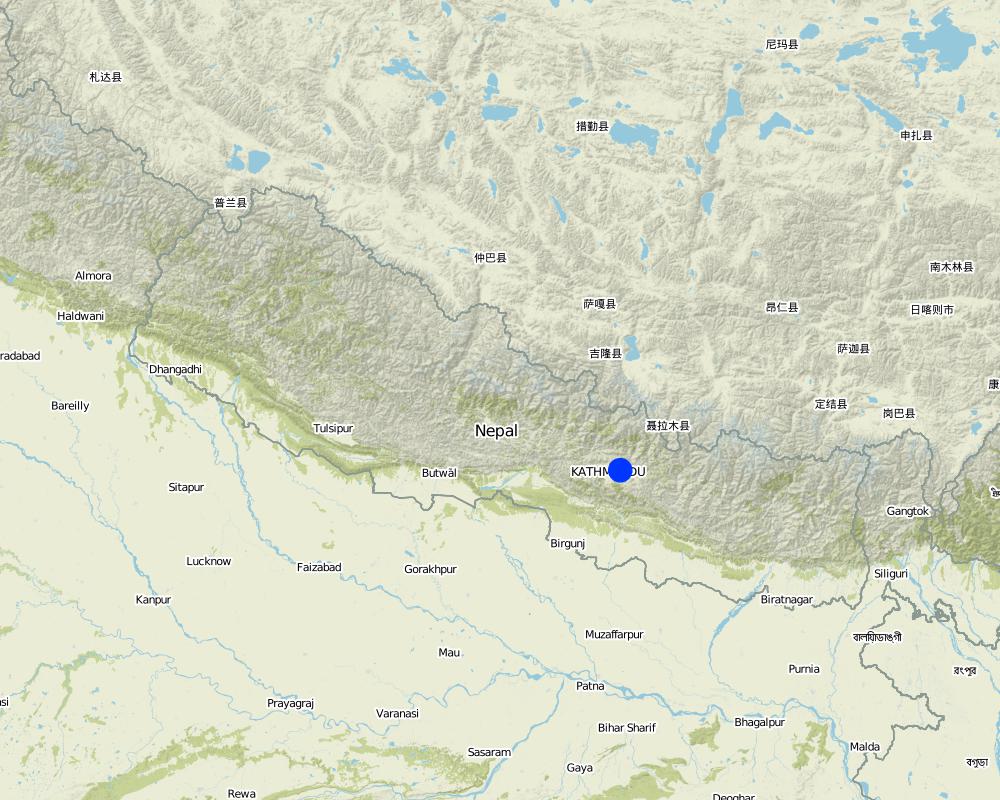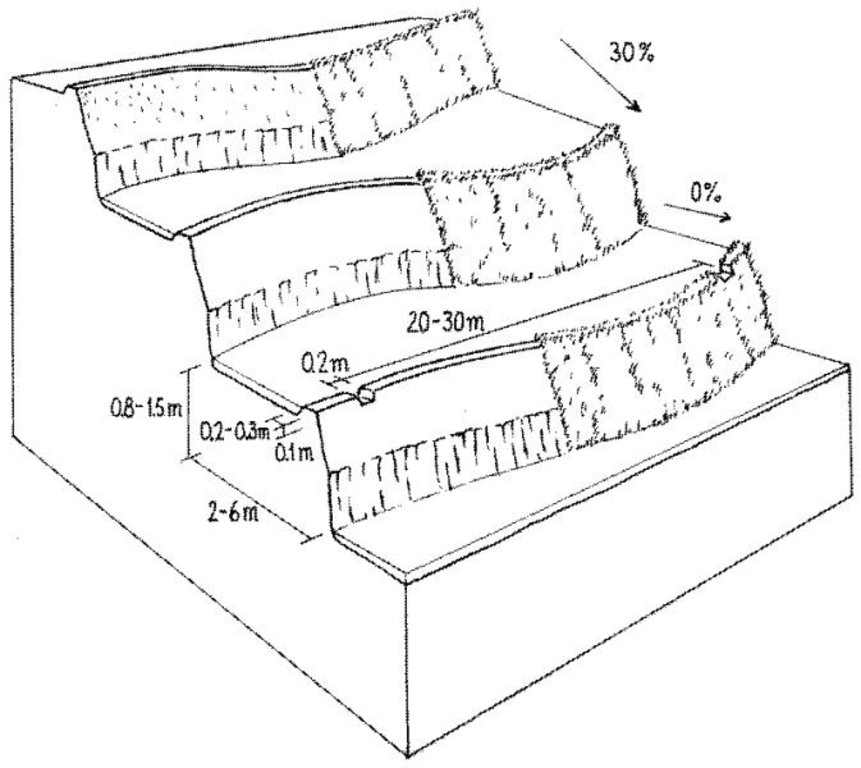Traditional irrigated rice terraces [Népal]
- Création :
- Mise à jour :
- Compilateur : Ramanand Bhattarai
- Rédacteur : –
- Examinateurs : David Streiff, Deborah Niggli, Alexandra Gavilano
Tari khet (Nepali)
technologies_1099 - Népal
Voir les sections
Développer tout Réduire tout1. Informations générales
1.2 Coordonnées des personnes-ressources et des institutions impliquées dans l'évaluation et la documentation de la Technologie
Spécialiste GDT:
Nom du projet qui a facilité la documentation/ l'évaluation de la Technologie (si pertinent)
Book project: where the land is greener - Case Studies and Analysis of Soil and Water Conservation Initiatives Worldwide (where the land is greener)Nom du ou des institutions qui ont facilité la documentation/ l'évaluation de la Technologie (si pertinent)
District Soil Conservation Office (DSCO) - NépalNom du ou des institutions qui ont facilité la documentation/ l'évaluation de la Technologie (si pertinent)
ICIMOD International Centre for Integrated Mountain Development (ICIMOD) - Népal1.3 Conditions relatives à l'utilisation par WOCAT des données documentées
Le compilateur et la(les) personne(s) ressource(s) acceptent les conditions relatives à l'utilisation par WOCAT des données documentées:
Oui
2. Description de la Technologie de GDT
2.1 Courte description de la Technologie
Définition de la Technologie:
Level bench terraces with risers protected by fodder grasses, used for the irrigated production of rice, potatoes and wheat
2.2 Description détaillée de la Technologie
Description:
The level bench terrace is a traditional technology that makes irrigated crop production possible on steep, erosion prone slopes. The majority of such terraces in Nepal were constructed by hand many generations ago, but some new land - mostly already under rainfed cultivation on forward sloping terraces - is still being converted into irrigated terraces. The initial costs for the construction of the terraces are extremely high – and annual maintenance costs are considerable also. The climate is humid subtropical, slopes are steep (30%-60%) and soils generally have a sandy loam texture. Terraces are cropped by farmers who mostly have less than 0.5 ha of land each.
Two to three annual crops are grown per year starting with paddy rice during the monsoon, followed by potatoes and/or wheat.
While terrace beds are usually 2–6 m in width, to save labour they are made as wide as they can be without increasing the danger of slips/land slides. Surveying was traditionally done by eye, but now a water-tube level may be used. Risers are 0.8-1.5 m high with a small lip (20-25 cm). The slope of the riser varies from 80 to 160%, depending on the initial gradient of the hill. Stones are incorporated in the risers if available, and grass species such as bermuda grass (Cynodon dactylon) and napier (Pennisetum purpureum) may be planted for stabilisation and as cattle fodder. The risers are compacted (with hoes) to improve ponding conditions for the paddy rice. Twice per year the risers are scraped with a special tool: (1) at the time of land preparation for paddy rice the lower part of riser is sliced, but the upper part is left protected with grasses against the monsoon rains; (2) at the time of wheat planting the whole riser (including the lip) is scraped and spread as green manure on the terrace.
Terraces are flooded with water for paddy rice cultivation: a smaller amount of water is diverted into the fields for other crops. Excess water is drained to the lower terrace by openings in the lip, which are filled with rice straw in order to filter out sediments. The depth of water for rice - when flooded completely - is normally between 10 and 15 cm. Fertility is maintained by addition of farmyard manure, spreading the scraped soil from the riser, and also through sediment carried in the irrigation water. Nowadays, mineral fertilizers are also applied.
2.3 Photos de la Technologie
2.5 Pays/ région/ lieux où la Technologie a été appliquée et qui sont couverts par cette évaluation
Pays:
Népal
Région/ Etat/ Province:
Kathmandu
Autres spécifications du lieu:
Manmata subwatershed
Spécifiez la diffusion de la Technologie:
- répartie uniformément sur une zone
Si la Technologie est uniformément répartie sur une zone, précisez la superficie couverte (en km2):
1,0
S'il n'existe pas d'informations exactes sur la superficie, indiquez les limites approximatives de la zone couverte:
- 0,1-1 km2
Commentaires:
Total area covered by the SLM Technology is 1 km2.
Map
×3. Classification de la Technologie de GDT
3.1 Principal(aux) objectif(s) de la Technologie
- améliorer la production
3.2 Type(s) actuel(s) d'utilisation des terres, là où la Technologie est appliquée

Terres cultivées
- Cultures annuelles
Cultures annuelles - Précisez les cultures:
- céréales - riz (de terres humides)
- plantes à racines et à tubercules - pommes de terre
- wheat
Nombre de période de croissance par an: :
- 2
Précisez:
Longest growing period in days: 150 Longest growing period from month to month: Jun - Oct Second longest growing period in days: 120 Second longest growing period from month to month: Nov - Feb
Commentaires:
Major cash crop: Potatoes
Major food crop: Rice and wheat
Major land use problems (compiler’s opinion): - steep slopes, not suitable for agriculture in their original state (better for forestry, agroforestry, horticulture, and fruit
trees)
- small and scattered plots of land
- land users find chemical fertilizers and water expensive
- there is water scarcity from September to May and too much rain in the monsoon period (June to August) with the danger of erosion and collapse of the terraces
3.4 Approvisionnement en eau
Approvisionnement en eau des terres sur lesquelles est appliquée la Technologie:
- pluvial
3.5 Groupe de GDT auquel appartient la Technologie
- mesures en travers de la pente
3.6 Mesures de GDT constituant la Technologie

pratiques agronomiques
- A2: Matière organique/ fertilité du sol

pratiques végétales
- V2: Herbes et plantes herbacées pérennes

structures physiques
- S1: Terrasses
Commentaires:
Main measures: agronomic measures, vegetative measures, structural measures
Type of agronomic measures: manure / compost / residues, mineral (inorganic) fertilizers
3.7 Principaux types de dégradation des terres traités par la Technologie

érosion hydrique des sols
- Wt: perte de la couche superficielle des sols (couche arable)/ érosion de surface
- Wg: ravinement/ érosion en ravines
- Wm: mouvements de masse/ glissements de terrain
Commentaires:
Main type of degradation addressed: Wt: loss of topsoil / surface erosion, Wg: gully erosion / gullying, Wm: mass movements / landslides
3.8 Prévention, réduction de la dégradation ou réhabilitation des terres dégradées
Spécifiez l'objectif de la Technologie au regard de la dégradation des terres:
- prévenir la dégradation des terres
4. Spécifications techniques, activités, intrants et coûts de mise en œuvre
4.1 Dessin technique de la Technologie
Spécifications techniques (associées au dessin technique):
Layout of irrigated terraces. Openings in the lips drain excess water, grass cover stabilises lips and risers (right). After harvesting of rice, the grass is scraped off the lower part of the risers (left) and spread on the terrace beds
Technical knowledge required for field staff / advisors: high
Technical knowledge required for land users: high
Main technical functions: reduction of slope angle, reduction of slope length, increase / maintain water stored in soil, control of dispersed and concentrated runoff, increase in soil fertility
Secondary technical functions: improvement of ground cover, water harvesting / increase water supply, water spreading
Manure / compost / residues
Material/ species: green/farmyard manure
Vegetative measure: fodder grass at risers
Terrace
Material: earth
Auteur:
Mats Gurtner
4.2 Informations générales sur le calcul des intrants et des coûts
Spécifiez la manière dont les coûts et les intrants ont été calculés:
- par superficie de la Technologie
Indiquez la taille et l'unité de surface:
ha
Indiquez la monnaie utilisée pour le calcul des coûts:
- dollars américains
4.3 Activités de mise en place/ d'établissement
| Activité | Calendrier des activités (saisonnier) | |
|---|---|---|
| 1. | Planting grasses including bermuda grass (Cynodon dactylon). | during monsoon |
| 2. | Construct bunds (risers) with soil from upper and lower sides | before monsoon |
| 3. | Level terrace beds (soil moved from upper to lower part of terraces). | before monsoon |
| 4. | Make lips on edges of terraces | before monsoon |
| 5. | Compact risers | before monsoon |
| 6. | Construct irrigation canal | before monsoon |
| 7. | Make openings in lips for drainage of excess water | before monsoon |
| 8. | Test-irrigate terrace for accurate levelling | during monsoon |
| 9. | Plant grasses including Bermuda grass (Cynodon dactylon) | during monsoon |
| 10. | After 2–3 years: some narrow terraces may be merged to form single, wider terraces | during monsoon |
4.5 Activités d'entretien/ récurrentes
| Activité | Calendrier/ fréquence | |
|---|---|---|
| 1. | Flood the paddy fields .. | (June/July) / Repeated 3–4 times during |
| 2. | Slice/scrape grass and soil on lower part of risers and spread on terraces | (when flooded, June/July) / |
| 3. | Plant rice and apply mineral fertilizer | (June/July). / |
| 4. | Harvest rice | (October) / |
| 5. | Apply manure (cattle manure), after rice harvest | (October). / |
| 6. | Slice/scrape grass and soil from whole of risers and spread on terraces; repairsmall collapses/slumps in risers | (October/November) / |
| 7. | Pprepare land | (November) / |
| 8. | Apply mineral fertilizer | (November/December). / |
| 9. | Irrigate | Nov. / repeated several times during cultivation |
| 10. | Harvest of potato/wheat | (January-March). / |
| 11. | Planting of rice | June,July / |
| 12. | planting of potatoes, wheat | November / |
| 13. | Repair of small collapses/slumps in risers. | (Oct./Nov.)/ |
4.6 Coûts et intrants nécessaires aux activités d'entretien/ récurrentes (par an)
| Spécifiez les intrants | Unité | Quantité | Coûts par unité | Coût total par intrant | % des coût supporté par les exploitants des terres | |
|---|---|---|---|---|---|---|
| Main d'œuvre | Labour | ha | 1,0 | 350,0 | 350,0 | 100,0 |
| Equipements | Tools | ha | 1,0 | 5,0 | 5,0 | 100,0 |
| Engrais et biocides | Fertilizer | ha | 1,0 | 185,0 | 185,0 | 100,0 |
| Engrais et biocides | Compost/manure | ha | 1,0 | 300,0 | 300,0 | 100,0 |
| Coût total d'entretien de la Technologie | 840,0 | |||||
| Coût total d'entretien de la Technologie en dollars américains (USD) | 840,0 | |||||
Commentaires:
Machinery/ tools: hoe, spade, baskets, (doko), special tool for scraping
Current establishment costs are very difficult to determine since the majority of the traditional terraces were
established a long time ago. Costs depend closely on the present state of the land (forward sloping terraces or uncultivated) and the need for irrigation canals. Farmers say that construction now could cost up to US$ 10,000 per ha if carried out by hand at full labour cost. The cost given for maintening the terraces (approx. US$ 840 per ha) includes all associated annual crop production costs. In this case study, 100% of the construction costs were borne by land users.
5. Environnement naturel et humain
5.1 Climat
Précipitations annuelles
- < 250 mm
- 251-500 mm
- 501-750 mm
- 751-1000 mm
- 1001-1500 mm
- 1501-2000 mm
- 2001-3000 mm
- 3001-4000 mm
- > 4000 mm
Zone agro-climatique
- humide
Thermal climate class: subtropics
5.2 Topographie
Pentes moyennes:
- plat (0-2 %)
- faible (3-5%)
- modéré (6-10%)
- onduleux (11-15%)
- vallonné (16-30%)
- raide (31-60%)
- très raide (>60%)
Reliefs:
- plateaux/ plaines
- crêtes
- flancs/ pentes de montagne
- flancs/ pentes de colline
- piémonts/ glacis (bas de pente)
- fonds de vallée/bas-fonds
Zones altitudinales:
- 0-100 m
- 101-500 m
- 501-1000 m
- 1001-1500 m
- 1501-2000 m
- 2001-2500 m
- 2501-3000 m
- 3001-4000 m
- > 4000 m
5.3 Sols
Profondeur moyenne du sol:
- très superficiel (0-20 cm)
- superficiel (21-50 cm)
- modérément profond (51-80 cm)
- profond (81-120 cm)
- très profond (>120 cm)
Texture du sol (de la couche arable):
- grossier/ léger (sablonneux)
- moyen (limoneux)
Matière organique de la couche arable:
- moyen (1-3%)
Si disponible, joignez une description complète du sol ou précisez les informations disponibles, par ex., type de sol, pH/ acidité du sol, capacité d'échange cationique, azote, salinité, etc.
Soil fertility is medium
Soil drainage / infiltration is good because of the geology and soil texture (loam)
5.6 Caractéristiques des exploitants des terres appliquant la Technologie
Orientation du système de production:
- exploitation mixte (de subsistance/ commerciale)
Revenus hors exploitation:
- 10-50% de tous les revenus
Individus ou groupes:
- individu/ ménage
Niveau de mécanisation:
- travail manuel
- traction animale
Indiquez toute autre caractéristique pertinente des exploitants des terres:
Off-farm income specification: hired labour (on other farmers’ fields) or as porters
Market orientation of production system: Subsistence (rice/wheat) and commercial (potatoes)
5.7 Superficie moyenne des terres utilisées par les exploitants des terres appliquant la Technologie
- < 0,5 ha
- 0,5-1 ha
- 1-2 ha
- 2-5 ha
- 5-15 ha
- 15-50 ha
- 50-100 ha
- 100-500 ha
- 500-1 000 ha
- 1 000-10 000 ha
- > 10 000 ha
5.8 Propriété foncière, droits d’utilisation des terres et de l'eau
Propriété foncière:
- individu, sans titre de propriété
Droits d’utilisation des terres:
- loué
- individuel
Commentaires:
Land use rights: leased (90% of farmers), individual (10%)
6. Impacts et conclusions
6.1 Impacts sur site que la Technologie a montrés
Impacts socio-économiques
Production
production agricole
production fourragère
qualité des fourrages
surface de production
gestion des terres
Commentaires/ spécifiez:
the technology is a part of a complex farming system
Revenus et coûts
dépenses pour les intrants agricoles
revenus agricoles
disparités économiques
Commentaires/ spécifiez:
not everyone has access to land for irrigation
charge de travail
Autres impacts socio-économiques
Livestock fodder
Impacts socioculturels
institutions communautaires
connaissances sur la GDT/ dégradation des terres
apaisement des conflits
Commentaires/ spécifiez:
when the agreed and scheduled water extraction amounts are exceeded
Impacts écologiques
Cycle de l'eau/ ruissellement
drainage de l'excès d'eau
Sols
humidité du sol
couverture du sol
perte en sol
Réduction des risques de catastrophe et des risques climatiques
glissements de terrains/coulées de débris
Commentaires/ spécifiez:
poor maintenance of topmost terraces may cause landslides
Autres impacts écologiques
Soil fertility
Biodiversity
Number of crabs in irrigation water make holes in the terrace risers
Commentaires/ spécifiez:
which in turn can cause pipe erosion and riser collapse
6.2 Impacts hors site que la Technologie a montrés
flux des cours d'eau fiables et stables en saison sèche
inondations en aval
envasement en aval
pollution des rivières/ nappes phréatiques
Groundwater recharge
Soil moisture and nutrients downstream
6.3 Exposition et sensibilité de la Technologie aux changements progressifs et aux évènements extrêmes/catastrophes liés au climat (telles que perçues par les exploitants des terres)
Changements climatiques progressifs
Changements climatiques progressifs
| Saison | Augmentation ou diminution | Comment la Technologie fait-elle face à cela? | |
|---|---|---|---|
| températures annuelles | augmente | bien |
Extrêmes climatiques (catastrophes)
Catastrophes météorologiques
| Comment la Technologie fait-elle face à cela? | |
|---|---|
| pluie torrentielle locale | pas bien |
| tempête de vent locale | pas bien |
Catastrophes climatiques
| Comment la Technologie fait-elle face à cela? | |
|---|---|
| sécheresse | pas bien |
Catastrophes hydrologiques
| Comment la Technologie fait-elle face à cela? | |
|---|---|
| inondation générale (rivière) | pas bien |
Autres conséquences liées au climat
Autres conséquences liées au climat
| Comment la Technologie fait-elle face à cela? | |
|---|---|
| réduction de la période de croissance | pas bien |
6.4 Analyse coûts-bénéfices
Quels sont les bénéfices comparativement aux coûts de mise en place (du point de vue des exploitants des terres)?
Rentabilité à court terme:
très négative
Rentabilité à long terme:
positive
Quels sont les bénéfices comparativement aux coûts d'entretien récurrents (du point de vue des exploitants des terres)?
Rentabilité à court terme:
positive
Rentabilité à long terme:
très positive
6.5 Adoption de la Technologie
De tous ceux qui ont adopté la Technologie, combien d'entre eux l'ont fait spontanément, à savoir sans recevoir aucune incitation matérielle, ou aucune rémunération? :
- 91-100%
Commentaires:
100% of land user families have adopted the Technology without any external material support
6.7 Points forts/ avantages/ possibilités de la Technologie
| Points forts/ avantages/ possibilités du point de vue du compilateur ou d'une autre personne ressource clé |
|---|
|
Income and production increased How can they be sustained / enhanced? Proper management of the terraces (including all maintenance activities) |
| Easier to cultivate flat terraces/less labour required (after establishment of terraces) |
|
Work sharing: traditional terraces are part of a long tradition of work sharing within the community with no external labourneeded How can they be sustained / enhanced? Prevent loss of well established traditions and norms |
|
Technology is easy to understand/apply. Increased opportunities for irrigation facilities: farmers without level terraces are not allowed (by the irrigation committee at village level) or do not claim irrigation water |
|
The irrigation element of this technology fosters social bonds within the community How can they be sustained / enhanced? Prevent loss of well established norms and traditions. |
6.8 Faiblesses/ inconvénients/ risques de la Technologie et moyens de les surmonter
| Faiblesses/ inconvénients/ risques du point de vue du compilateur ou d'une autre personne ressource clé | Comment peuvent-ils être surmontés? |
|---|---|
| Decreased grass production (grazing area reduced) | Promote planting of high value grass species on risers (such as bermuda grass). |
| The farmers believe that the terraces are too narrow (for efficient use of tractors); they would like to have wider terraces |
Investigate possibilities of constructing wider paddy rice terraces on steep slopes, which, according to present experience, is not possible. |
| High labour costs for establishment. |
7. Références et liens
7.1 Méthodes/ sources d'information
7.2 Références des publications disponibles
Titre, auteur, année, ISBN:
There is considerable literature on the construction and maintenance of irrigated terraces in general, but no references thatspecifically describe the traditional paddy rice terraces in Nepal
Liens et modules
Développer tout Réduire toutLiens
Aucun lien
Modules
Aucun module trouvé


